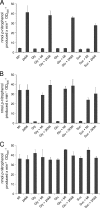Inositol catabolism, a key pathway in sinorhizobium meliloti for competitive host nodulation
- PMID: 20971862
- PMCID: PMC3008233
- DOI: 10.1128/AEM.01972-10
Inositol catabolism, a key pathway in sinorhizobium meliloti for competitive host nodulation
Abstract
The nitrogen-fixing symbiont of alfalfa, Sinorhizobium meliloti, is able to use myo-inositol as the sole carbon source. Putative inositol catabolism genes (iolA and iolRCDEB) have been identified in the S. meliloti genome based on their similarities with the Bacillus subtilis iol genes. In this study, functional mutational analysis revealed that the iolA and iolCDEB genes are required for growth not only with the myo-isomer but also for growth with scyllo- and d-chiro-inositol as the sole carbon source. An additional, hypothetical dehydrogenase of the IdhA/MocA/GFO family encoded by the smc01163 gene was found to be essential for growth with scyllo-inositol, whereas the idhA-encoded myo-inositol dehydrogenase was responsible for the oxidation of d-chiro-inositol. The putative regulatory iolR gene, located upstream of iolCDEB, encodes a repressor of the iol genes, negatively regulating the activity of the myo- and the scyllo-inositol dehydrogenases. Mutants with insertions in the iolA, smc01163, and individual iolRCDE genes could not compete against the wild type in a nodule occupancy assay on alfalfa plants. Thus, a functional inositol catabolic pathway and its proper regulation are important nutritional or signaling factors in the S. meliloti-alfalfa symbiosis.
Figures




Similar articles
-
The RpiR-like repressor IolR regulates inositol catabolism in Sinorhizobium meliloti.J Bacteriol. 2011 Oct;193(19):5155-63. doi: 10.1128/JB.05371-11. Epub 2011 Jul 22. J Bacteriol. 2011. PMID: 21784930 Free PMC article.
-
A functional myo-inositol dehydrogenase gene is required for efficient nitrogen fixation and competitiveness of Sinorhizobium fredii USDA191 to nodulate soybean (Glycine max [L.] Merr.).J Bacteriol. 2001 Apr;183(8):2595-604. doi: 10.1128/JB.183.8.2595-2604.2001. J Bacteriol. 2001. PMID: 11274120 Free PMC article.
-
The Sinorhizobium meliloti RNA chaperone Hfq influences central carbon metabolism and the symbiotic interaction with alfalfa.BMC Microbiol. 2010 Mar 6;10:71. doi: 10.1186/1471-2180-10-71. BMC Microbiol. 2010. PMID: 20205931 Free PMC article.
-
[Root Nodule Bacteria Sinorhizobium meliloti: Tolerance to Salinity and Bacterial Genetic Determinants].Mikrobiologiia. 2015 May-Jun;84(3):263-80. Mikrobiologiia. 2015. PMID: 26263687 Review. Russian.
-
Metabolism in the Niche: a Large-Scale Genome-Based Survey Reveals Inositol Utilization To Be Widespread among Soil, Commensal, and Pathogenic Bacteria.Microbiol Spectr. 2022 Aug 31;10(4):e0201322. doi: 10.1128/spectrum.02013-22. Epub 2022 Aug 4. Microbiol Spectr. 2022. PMID: 35924911 Free PMC article. Review.
Cited by
-
Ensifer meliloti overexpressing Escherichia coli phytase gene (appA) improves phosphorus (P) acquisition in maize plants.Naturwissenschaften. 2016 Oct;103(9-10):76. doi: 10.1007/s00114-016-1400-1. Epub 2016 Sep 5. Naturwissenschaften. 2016. PMID: 27597170
-
Analysis of Ensifer aridi Mutants Affecting Regulation of Methionine, Trehalose, and Inositol Metabolisms Suggests a Role in Stress Adaptation and Symbiosis Development.Microorganisms. 2022 Jan 26;10(2):298. doi: 10.3390/microorganisms10020298. Microorganisms. 2022. PMID: 35208753 Free PMC article.
-
Competition Experiments for Legume Infection Identify Burkholderia phymatum as a Highly Competitive β-Rhizobium.Front Microbiol. 2017 Aug 15;8:1527. doi: 10.3389/fmicb.2017.01527. eCollection 2017. Front Microbiol. 2017. PMID: 28861050 Free PMC article.
-
RNA sequencing analysis of the broad-host-range strain Sinorhizobium fredii NGR234 identifies a large set of genes linked to quorum sensing-dependent regulation in the background of a traI and ngrI deletion mutant.Appl Environ Microbiol. 2014 Sep;80(18):5655-71. doi: 10.1128/AEM.01835-14. Epub 2014 Jul 7. Appl Environ Microbiol. 2014. PMID: 25002423 Free PMC article.
-
Competition, Nodule Occupancy, and Persistence of Inoculant Strains: Key Factors in the Rhizobium-Legume Symbioses.Front Plant Sci. 2021 Aug 19;12:690567. doi: 10.3389/fpls.2021.690567. eCollection 2021. Front Plant Sci. 2021. PMID: 34489993 Free PMC article. Review.
References
-
- Anderson, L. 1972. The cyclitols, p. 519-579. In W. Pigman and D. Horton (ed.), The carbohydrates, 2nd ed., vol. 1A. Academic Press, New York, NY.
-
- Bahar, M., J. de Majnik, M. Wexler, J. Fry, P. S. Poole, and P. J. Murphy. 1998. A model for the catabolism of rhizopine in Rhizobium leguminosarum involves a ferredoxin oxygenase complex and the inositol degradative pathway. Mol. Plant Microbe Interact. 11:1057-1068. - PubMed
-
- Beringer, J. E. 1974. R factor transfer in Rhizobium leguminosarum. J. Gen. Microbiol. 84:188-198. - PubMed
-
- Berman, T., and B. Magasanik. 1966. The pathway of myo-inositol degradation in Aerobacter aerogenes: dehydrogenation and dehydration. J. Biol. Chem. 241:800-806. - PubMed
Publication types
MeSH terms
Substances
LinkOut - more resources
Full Text Sources
Other Literature Sources
Molecular Biology Databases

